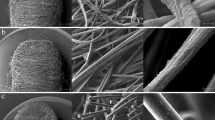Abstract
The desorption ofStaphylococcus aureus, Acinetobacter calcoaceticus, and a coryneform from the surfaces of materials used for manufacturing food containers (glass, tin plate, and polypropylene) or postprocess canning factory conveyor belts (stainless steel and nylon) was investigated. The effect of time, pH, temperature, and adsorbed organic layers on desorption was studied.S. aureus did not detach from the substrata at any pH investigated (between pH 5 and 9).A. calcoaceticus and the coryneform in some cases detached, depending upon pH and substratum composition. The degree of bacterial detachment from the substrata was not related to bacterial respiration at experimental pH values. Bacterial desorption was not affected by temperature (4–30°C) nor by an adsorbed layer of peptone and yeast extract on the substrata. The results indicate that bacterial desorption, hence bacterial removal during cleaning or their transfer via liquids flowing over colonized surfaces, is likely to vary with the surface composition and the bacterial species colonizing the surfaces.
Similar content being viewed by others
References
Baier RE (1981) Substrata influences on adhesion of microorganisms and their resultant new surface properties. In: Bitton G, Marshall KC (eds) Adsorption of microorganisms to surfaces. John Wiley and Sons, New York, pp 59–104
Baier RE (1982) Conditioning surfaces to suit the biomedical environment: recent progress. J Biomech Eng 104:257–271
Bright JJ, Fletcher M (1983) Amino acid assimilation and electron transport system activity in attached and free-living marine bacteria. Appl Environ Microbiol 45:818–825
Characklis WG (1984) Biofllm development: a process analysis. In: Marshall KC (ed) Microbial adhesion and aggregation. Springer-Verlag, Berlin, pp 137–157
Corpe WA (1974) Detachment of marine periphytic bacteria from surfaces of glass slides. Dev Indust Microbiol 15:281–287
Costerton JW, Cheng K-J (1982) Microbe-microbe interactions at surfaces. In: Burns RG, Slater JH (eds) Experimental microbial ecology. Blackwell Scientific Publishers, Oxford, England, pp 275–290
Dexter SC (1977) Influence of substrate wettability on the formation of bacterial slime films on solid surfaces immersed in natural sea water. In: Romanovsky V (ed) Proc 4th Intl Cong on Marine Corrosion and Fouling, Centre de Recherches et d'Etudes Oceanographiques, Boulogne, France, pp 137–144
Fletcher M (1986) Measurement of glucose utilization byPseudomonas fluorescens that are free living and that are attached to surfaces. Appl Environ Microbiol 52:672–676
Fletcher M, Marshall KC (1982) Bubble contact angle method for evaluating substratum interfacial characteristics and its relevance to bacterial attachment. Appl Environ Microbiol 44:184–192
Kjelleberg S, Hermansson M (1984) Starvation-induced effects on bacterial surface characteristics. Appl Environ Microbiol 84:497–503
Kovacs N (1956) Identification ofPseudomonas pyocyanea by the oxidase reaction. Nature 178:703–708
Ludwicka A, Jansen B, Wadström T, Pulverer G (1984) Attachment of staphylococci to various synthetic polymers. ZBl Bakt Hyg A 256:479–489
MacFaddin JF (1976) Biochemical tests for identification of medical bacteria. Williams and Wilkins Co, Baltimore
Marshall KC (1967) Electrophoretic properties of fast- and slow-growing species ofRhizobium. Aust J Biol Sci 20:429–438
Marshall KC (1985) Mechanisms of bacterial adhesion at solid-water interfaces. In: Savage DC, Fletcher M (eds) Bacterial adhesion. Plenum Press, New York, pp 133–161
McEldowney S, Fletcher M (1986) Effect of growth conditions and surface characteristics of aquatic bacteria on their attachment to solid surfaces. J Gen Microbiol 132:513–523
McEldowney S, Fletcher M (1986) Variability in the influence of physicochemical factors affecting bacterial adhesion to polystyrene substrata. Appl Environ Microbiol 52:460–465
Minato H, Suto T (1976) Technique for fractionation of bacteria in rumen microbial ecosystem. I. Attachment of rumen bacteria to starch granules and elution of bacteria attached to them. J Gen Appl Microbiol 22:259–276
Minato H, Suto T (1979) Technique for fractionation of bacteria in rumen microbial ecosystem. III. Attachment of bacteria isolated from bovine rumen to starch granules in vitro and elution of bacteria attached therefrom. J Gen Appl Microbiol 25:71–93
Paul JH, Jeffray WH (1985) Evidence for separate adhesion mechanisms for hydrophilic and hydrophobic surfaces inVibrio proteolytica. Appl Environ Microbiol 50:431–437
Powell SM, Slater NKH (1982) Removal rates of bacterial cells from glass surfaces by fluid shear. Biotech Bioeng 24:2527–2537
Pringle JH, Fletcher M (1983) Influence of substratum wettability on attachment of freshwater bacteria to solid surfaces. Appl Environ Microbiol 45:811–817
Rutter PR, Vincent B (1984) Physicochemical interactions of the substratum, microorganisms, and the fluid phase. In: Marshall KC (ed) Microbial adhesion and aggregation. Springer-Verlag, Berlin, pp 21–38
Scheraga M, Meskill M, Litchfield CD (1979) Analysis of methods for the quantitative recovery of bacteria sorbed onto marine sediments. In: Litchfield CD, Seigfried PL (eds) Methodology of biomass determinations and microbial activities in sediments. American Society for Testing & Materials Special Technical Publication 673, pp 21–39
Stanley PM (1983) Factors affecting the irreversible attachment ofPseudomonas aeruginosa to stainless steel. Can J Microbiol 29:1493–1499
Van Pelt AWJ, Weerkamp AH, Uyen MHWJC, Busscher HJ, de Jong HP, Arends J (1985) Adhesionof Streptococcus sanguis CH3 to polymers with different surface-free energies. Appl Environ Microbiol 49:1270–1275
Zvyagintsev DG (1959) Adsorption of microorganisms by glass surfaces. Microbiology (USSR) (Eng trans) 28:104–108
Zvyagintsev DG, Guzev VS (1971) Concentration and separation of bacteria on Dowex anionite. Microbiology (USSR) (Eng trans) 40:139–143
Author information
Authors and Affiliations
Rights and permissions
About this article
Cite this article
McEldowney, S., Fletcher, M. Bacterial desorption from food container and food processing surfaces. Microb Ecol 15, 229–237 (1988). https://doi.org/10.1007/BF02011715
Issue Date:
DOI: https://doi.org/10.1007/BF02011715




